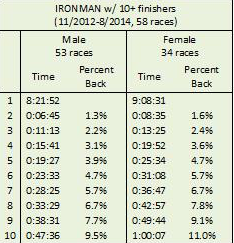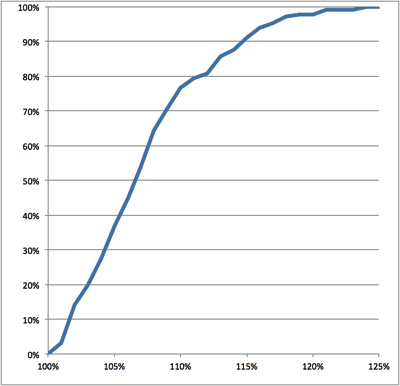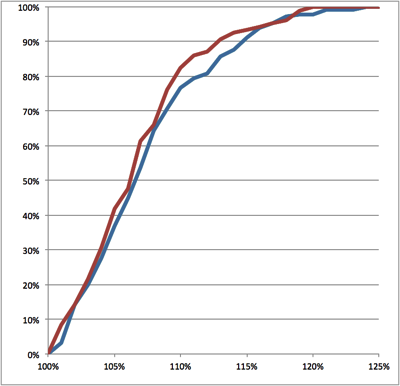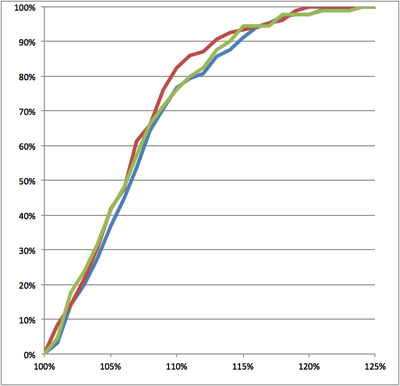One of the ongoing issues in Ironman racing is the disparity between Pro men and Pro women slots in Kona (50 for men, 35 for women). The main argument for the different number of slots is that there are a lot more men than women racing. Roughly, there is a relation of 2 men to 1 women that has been pretty much unchanged in recent years.
However, women’s races are often more exciting than the men’s race. In one of my older posts on this issue I’ve presented data indicating that the racing at the front of the women’s race is probably even closer than on the men’s side. Arguments for that include the number of lead changes on the run, or the time difference among athletes on the podium.
However, the decision by WTC not to increase the number of women’s Kona slots seems to be based on the perception that men’s field is „deeper“ than the women’s field. This post has a look at this claim and tries to provide data.
Suggestions for Measuring Depth Of Field
There have been a few „proofs“ that the men’s field is deeper than women’s. However, they don’t hold up to closer scrutiny.
Kona 2014
I’ve heard Kona 2014 mentioned as anecdotal evidence that the women’s field was lacking strength. The observation was that by the time the field reached Kawaihae, 30 men were still in the race. At the same point in the women’s race, there were only ten contenders left.
Of course, using an arbitrary point in a single race is neither convincing nor statistically significant. There are tons of counterexamples, take for example Kona 2014 (the same race) about 30k into the run. At that time, the men’s race was practically decided with Sebastian Kienle 10 minutes ahead of the rest of the field, while there were at least three women with a chance to win the race (Daniela Ryf, Rachel Joyce and Mirinda Carfrae).
KPR Points at #50
Another argument that is used very often is the number of KPR points at #50. Here’s the data from 2014 (not using Automatic Qualifiers):
- Schildknecht 3.915 vs. Bazlen 3.595
There is only a 320 points difference, probably smaller than some proponents of this argument make it sound. Also, the difference is a consequence of #50 being interesting for the men and not interesting for the women. We can easily refute the argument that this shows a lack of depth for the women by looking at #35:
- Jurkiewicz 4.280 vs. Wee 5.040
While Bree has a lot more points than Jeremy, I don’t think that this shows that the men’s field is less deep than the women’s field – it just shows that #35 is interesting for the women and not for the men.
Time Differences
As an example of many similar lines of argument, Andrew Starykowicz has posted a detailed look at the time differences between the TopX in men’s and women’s fields. His data shows that the men’s races are much „tighter“ than the women’s races:

However, this ignores the fact that the women’s fields are smaller and that a smaller field leads to larger gaps between the finishers. To simplify a bit, if the women’s field is half as large as the men’s field, this leads to time differences twice as large (e.g. if the male have a difference at #10 of 9,5%, the expected female difference would be in the order of 19% instead of the observed 11%). So rather than show that the women’s fields are less competitive, the larger difference is more a sign of the smaller fields.
Races with Small Women’s Fields
Each season, there is at least won Pro race that has a very small women’s Pro field. In 2013 IM France had only five starters, in 2014 IM Wales had only two. Of course it’s always bad if prize money goes unclaimed (France paid 8 deep, Wales 6 deep), but I think that this is again a consequence of the lower number of women racing: There are too many races for the smaller women’s field. I have suggested in my post on the Registration Procedures that WTC should keep Pros informed about the number of athletes that have already suggested for a race so that these very low numbers can be avoided.
My Suggestion
It’s actually surprisingly hard to come up with a measurement for the depth of the field, considering the different field sizes and different finishing times. A way that I suggest are Relative Finish Distribution Charts („REFIDCHs“). A Relative Finish Distribution Chart shows the percentage of finishers for different percentages of the winner’s time. Here’s the chart for the men’s Kona finishers from 2011 to 2014 (the years that the KPR has been used to determine the fields):

On the horizontal axis we see the relative finishing time (for example 105% means that the time equivalent to 105% of the winners time in a given year). On the vertical axis the chart shows the part of the field that has finished faster than the time on the x-asis. (For example, roughly 35% of the athletes finished within 105% of the winner’s time.)
REFIDCHs can be used to visualize the depth of the field. A „deep“ field will finish pretty close to the winner, resulting in a very steep graph. A „less deep“ field will have a flatter curve, showing that more athletes have finished further away from the winner. So if the women in Kona were less competitive, they would have a flatter curve, one that would be to the right of the men’s graph.
So let’s add the women’s distribution:

The two graphs have a very similar shape – if there is a difference, the women’s graph is to the left of the men’s graph, indicating a slightly deeper women’s field.
Let’s control for the influence of the different field sizes. One could argue that the smaller women’s field cuts away the slower end of the field. (Anecdotally, this isn’t the case: Some women that missed Kona this year included athletes such as Amy Marsh, Angela Naeth, Rebekah Keat, Laura Bennett or Eimear Mullan that could have placed well in Kona.) This is pretty hard to factor into the data, so I’ve done the next best thing by removing the men’s qualifiers in #35 to #50 from the results. (For 2014, this would have affected such well-placed finishers as 2nd Ben Hoffman, 6th Nils Frommhold or 10th Romain Guillaume.) Adding in a third graph for the „reduced Men’s field“ produces the following chart:

While reducing the men’s field has led to a steeper graph (indicating that more athletes would have been cut from the „slower“ end of the field), the graphs are still very close together, crossing each other at various points. Using this chart, there is no indication that the women’s field is any less competitive or deep than the men’s field or even the reduced men’s field.
Conclusion
I couldn’t find any data that supports the claim that the depth of the women’s field is any worse than the men’s field. (If you have other suggestions, please let me know!) While the lower number of athletes leads to bigger gaps in the Ironman races across the globe, at least the women that made it to Kona are as competitive as their male counterparts. In my eyes, the women’s race in Kona would be even more exciting than it already is if there were 50 Pro slots for the women.
Pingback: Send 50 Women to Kona | Swim, Bike, Run, Repeat
Pingback: I’m Not Getting Into the 50 Women to Kona Debate (Because It’s Not a Debate) « It's Always Sunny Running
Pingback: R-evolution
I believe that using % of finishers on the y-axis is flawed methodology and is leading your conclusions astray.
Please see graphs here:
http://forum.slowtwitch.com/cgi-bin/gforum.cgi?post=5497413#5497413
I’ve posted the following reply on the Slowtwitch forum:
Sorry, I’m a bit late to the game, but still would like to reply.
I stand by my use of percentages of the field – only this way we can properly compare different field sizes. (Have a look at the section on “Time differences” in my post on the “Depth of Fields”.) Here’s a simple way of explaining this: Take the men’s Kona field (roughly 50 starters), then randomly remove 15 of these from the results (assuming “off-days”, mechanicals, being sick in the week before etc.) Obviously, this will increase the time differences between the finishers .. roughly speaking by 15/50 – so it isn’t fair to compare the 10th in the original field to the 10th in the thinned field, but probably the 10th to the 7th in the thinned field.
Pingback: Anything BUT Possible – Our Fight for Equality in Triathlon | Fewoman
“One could argue that the smaller women’s field cuts away the slower end of the field. […] This is pretty hard to factor into the data, so I’ve done the next best thing by removing the men’s qualifiers in #35 to #50 from the results.”
If the qualification process is so unsuccessful at finding the fastest women for Kona and your above assumption is correct, you could name 15 FPro with an average rating equal to the 35 participants’ average rating.
This made me realise you don’t have ranking lists other than the Top 10 (or I couldn’t find them). Which is a pitty, because you could establish “Thorsten’s Ironman distance World Ranking List”, where all (pro) athletes from around the world can compare themselves with each other, even if they never raced against each other. Isn’t that this website’s main goal?
I don’t think it’s correct to “remove the men’s qualifiers in #35 to #50 from the results” to “cut away the slower end of the field”, as some are qualifying with two races, some with three, and nobody cares if he is qualified as #34 or #50.
As a suggestion for analysis of depth of the field, do the “REFIDCHs” but use your TTR instead of the finishing time, as a lot of DNFs from slower athletes will influence the result. Your Rating is statistically more significant than the results of a single race with <30 finishers.
It seems the top10 are comparably competitive, but what about top35 or top50?
Using your own data for Kona 2016: Mauro Baertsch's Rating is 110% of Jan Frodeno's Rating, while Tine Holst's Rating is 113% of Daniela Ryf's Rating. Meaning the slowest MPro is more competitive than the slowest FPro. Igor Amorelli is at 107%.
Would be interesting to read your thoughts on this.
Comments are closed.